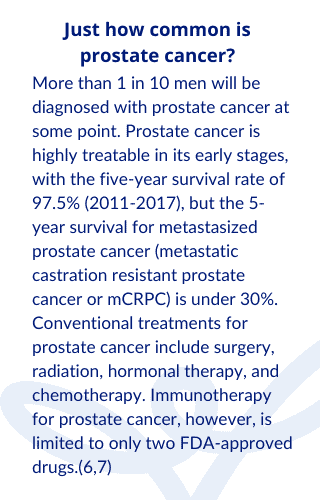[vc_row][vc_column][mpc_textblock content_width=”100″ font_preset=”preset_0″ margin_divider=”true” margin_css=”margin-top:20px;margin-bottom:20px;”]New Treatments Create Buzz Among Patients with Prostate Cancer and their Caregivers
[/mpc_textblock][vc_row_inner][vc_column_inner][mpc_image image=”13297″ image_size=”large” force_fullwidth=”true” image_opacity=”100″ image_inner_border_gap=”0″ effect=”none” image_hover_opacity=”100″][/vc_column_inner][/vc_row_inner][mpc_textblock content_width=”100″ font_preset=”preset_2″ margin_divider=”true” margin_css=”margin-top:20px;margin-bottom:20px;”]By Kathleen Hoffman, PhD MSPH
Prostate cancer is highly treatable in its early stages, much less so once it has metastasized, where the five-year survival rate is below 30%. In search of more treatment options, a patient with advanced prostate cancer wrote on Inspire:
I was diagnosed with prostate cancer in [date]. Have done virtually every procedure including the de Vinci surgery (cancer had gotten outside into my lymph nodes, so prostate was not removed), radiation, hormone treatments, and chemo therapy. Periodic bone scans showed the cancer in various areas and unfortunately continued to spread. To combat this condition, I received additional spot radiation in my pelvis, rib cage, foot and back.
Fortunately, new treatments have recently become available for patients with metastatic disease. In May 2021, the FDA approved piflufolastat (PYLARIFY®), a radiographic marker that aids in identifying prostate cancer cells in PET scans. The other drug, a molecule called 177Lu-PSMA-617, was granted breakthrough therapy designation by the FDA in June, accelerating its development. The molecule has shown effectiveness at targeting and killing prostate cancer cells directly.1,2
Radioligands
Both treatments are radioligands. This innovative therapy (radioligand therapy or RLT) uses a ligand (a molecule that binds to another, usually larger, molecule) to deliver radiation to a specific cell type. A targeted therapy, these prostate cancer radioligands irradiate cancer cells and spare normal cells. Both new treatments act by attaching to prostate-specific membrane antigen (PSMA), a protein on the surface of normal prostate cells that is found in higher amounts on prostate cancer cells.3,4,5
Piflufolastat: Lights up the target
Finding if and where prostate cancer has metastasized is made easier with piflufolastat (PYLARIFY), a radioactive diagnostic agent. When injected, it attaches itself to the surface of cells containing PSMA. When a patient undergoes a PET scan, piflufolastat causes the PSMA lesions to show up as bright spots on the scan. Piflufolastat is intended for patients whose prostate cancer is suspected to have metastasized but is still potentially curable, or for patients suspected of recurrence because of elevated prostate-specific antigen (PSA) levels.8,9
177Lu-PSMA-617: Direct Delivery
Where piflufolastat is a diagnostic aid, 177Lu-PSMA-617 directly targets PSMA-positive prostate cancer cells for cell death. It is similar to piflufolastat in that its ligand attaches itself to the PSMA expressed on cancer cell membranes. However, 177Lu-PSMA-617 then delivers a radioactive atom, Lutetium-177 (177Lu), that directly kills the cell and bypasses PSMA-negative healthy cells.
Its FDA breakthrough therapy designation was based on the results of the VISION clinical trial, which found that the molecule extended progression free survival (PFS) in patients with metastatic castration resistant prostate cancer (mCRPC) 8.7 months over the best standard of care’s 3.4 months, and overall survival (OS) to 15.3 months over 11.3 months. It is administered as a systemic bolus injection. Clinical trials are ongoing internationally and are listed on clinicaltrials.gov.10,11,12
Both drugs already being discussed on Inspire
The audience for prostate cancer on Inspire, estimated at over 60,000, is already discussing these new treatments:
The latest news said a pylarify psma was approved by FDA. Is it a new machine or just add a new tracer agent to the existing equipment?
I’m currently in the lu177 Pmsa trail here at U Colorado health center. The Mayo Clinic told me about the trail but they were full so they helped me get into Colorado. It is conducted at many locations in the US (and I think Europe). I have had 3 treatments so far (every 6 wks). PSA down to 3.97 from 7.12.
Patients and caregivers not only discuss their treatments and results, they keep each other informed of clinical trials as they become aware of them. Prostate cancer survivors also write about the emotional and social impacts that affect overall quality of life for families sharing this disease, a topic they find very important but glossed over or simply unmentioned by the medical profession. This large and active audience of over 60,000 members is looking for answers, whether the question is personal or scientific — and they often look to each other on Inspire.
[/mpc_textblock][/vc_column][/vc_row][vc_row css=”.vc_custom_1483606399832{padding-top: 20px !important;padding-bottom: 20px !important;}”][vc_column][vc_row_inner css=”.vc_custom_1496685033252{padding-bottom: 40px !important;}”][vc_column_inner width=”2/3″][mpc_textblock content_width=”100″ font_preset=”preset_2″ margin_divider=”true” margin_css=”margin-top:20px;margin-bottom:20px;”]Download the case study, “Recruiting Qualified Consented Patients Just Got Easier”[/mpc_textblock][mpc_button preset=”preset_1″ block=”true” url=”url:https%3A%2F%2Fcorp.inspire.com%2Fresource%2Frecruiting-qualified-consented-patients-just-got-easier%2F|title:Recruiting%20Qualified%2C%20Consented%20Patients%20Just%20Got%20Easier|target:_blank” font_preset=”preset_1″ font_color=”#ffffff” font_transform=”none” font_align=”center” title=”Download this case study” icon=”fa fa-angle-right” icon_color=”#ffffff” icon_size=”14″ icon_effect=”stay-left” icon_gap=”20″ background_color=”#084a8e” border_css=”border-radius:2px;” padding_divider=”true” padding_css=”padding-top:10px;padding-right:20px;padding-bottom:10px;padding-left:20px;” margin_divider=”true” margin_css=”margin-top:30px;” hover_font_color=”#ffffff” hover_icon_color=”#ffffff” hover_background_color=”#116eba”][/vc_column_inner][vc_column_inner width=”1/3″][mpc_image image=”13288″ image_link=”url:https%3A%2F%2Fcorp.inspire.com%2Fresource%2Frecruiting-qualified-consented-patients-just-got-easier%2F|title:Recruiting%20Qualified%2C%20Consented%20Patients%20Just%20Got%20Easier|target:_blank” image_size=”large” image_opacity=”100″ image_inner_border_gap=”0″ effect=”none” image_hover_opacity=”100″][/vc_column_inner][/vc_row_inner][flipbook-shelf ids=”humanizing_the_brand_experience, insights_from_engaged_patients, expert_by_experience_2016, expert_by_experience_2015, expert_by_experience_2014, case_studies_using_multimodal_research, case_study_prostate_cancer_consumer_support_group_survey, case_study_sleep_disorders_private_research_community”][mpc_callout layout=”style_8″ title_font_preset=”preset_5″ content_width=”100″ content_font_preset=”preset_2″ icon_disable=”true” background_color=”#e8e8e8″ border_css=”border-width:5px;border-color:#d3d3d3;border-style:solid;” padding_css=”padding:15px;” mpc_button__preset=”preset_1″ mpc_button__block=”true” mpc_button__url=”url:%2Fresources|||” mpc_button__font_preset=”preset_1″ mpc_button__font_color=”#ffffff” mpc_button__font_transform=”none” mpc_button__font_align=”center” mpc_button__title=”Learn More” mpc_button__icon=”fa fa-angle-right” mpc_button__icon_color=”#ffffff” mpc_button__icon_size=”14″ mpc_button__icon_effect=”stay-left” mpc_button__icon_gap=”20″ mpc_button__background_color=”#47aff3″ mpc_button__border_css=”border-radius:2px;” mpc_button__padding_divider=”true” mpc_button__padding_css=”padding-top:10px;padding-right:20px;padding-bottom:10px;padding-left:20px;” mpc_button__margin_divider=”true” mpc_button__margin_css=”margin-top:10px;” mpc_button__hover_font_color=”#ffffff” mpc_button__hover_icon_color=”#ffffff” mpc_button__hover_background_color=”#116eba”]Inspire offers a trusted community to patients and caregivers. Our goal with this blog, this website and our content is to provide the life science industry access to the true, authentic patient voice. In so doing, we support faithful operationalization of patient-centricity. Take a look at our case studies, eBooks and news outlet coverage.[/mpc_callout][/vc_column][/vc_row][vc_row][vc_column][mpc_textblock content_width=”100″]
References
1 https://www.fda.gov/drugs/drug-safety-and-availability/fda-approves-second-psma-targeted-pet-imaging-drug-men-prostate-cancer
2 https://www.cancer.gov/news-events/cancer-currents-blog/2021/prostate-cancer-psma-radiopharmaceutical-vision
3https://www.healthpolicypartnership.com/project/radioligand-therapy-project/
4 https://www.ncbi.nlm.nih.gov/pmc/articles/PMC1472940/
5https://www.cancer.gov/publications/dictionaries/cancer-terms/def/psma
6 https://seer.cancer.gov/statfacts/html/prost.html
7 https://www.cancerresearch.org/en-us/immunotherapy/cancer-types/prostate-cancer
8https://www.fda.gov/drugs/drug-safety-and-availability/fda-approves-second-psma-targeted-pet-imaging-drug-men-prostate-cancer
9https://www.fda.gov/news-events/press-announcements/fda-approves-first-psma-targeted-pet-imaging-drug-men-prostate-cancer
10https://www.purdue.edu/discoverypark/drug-discovery/clinical-translation/entities/177Lu-PSMA-617.php
11https://www.healio.com/news/hematology-oncology/20210617/fda-grants-breakthrough-designation-to-radioligand-therapy-for-advanced-prostate-cancer
12https://www.mskcc.org/news/new-therapy-promises-major-advance-treating-prostate
[/mpc_textblock][/vc_column][/vc_row]